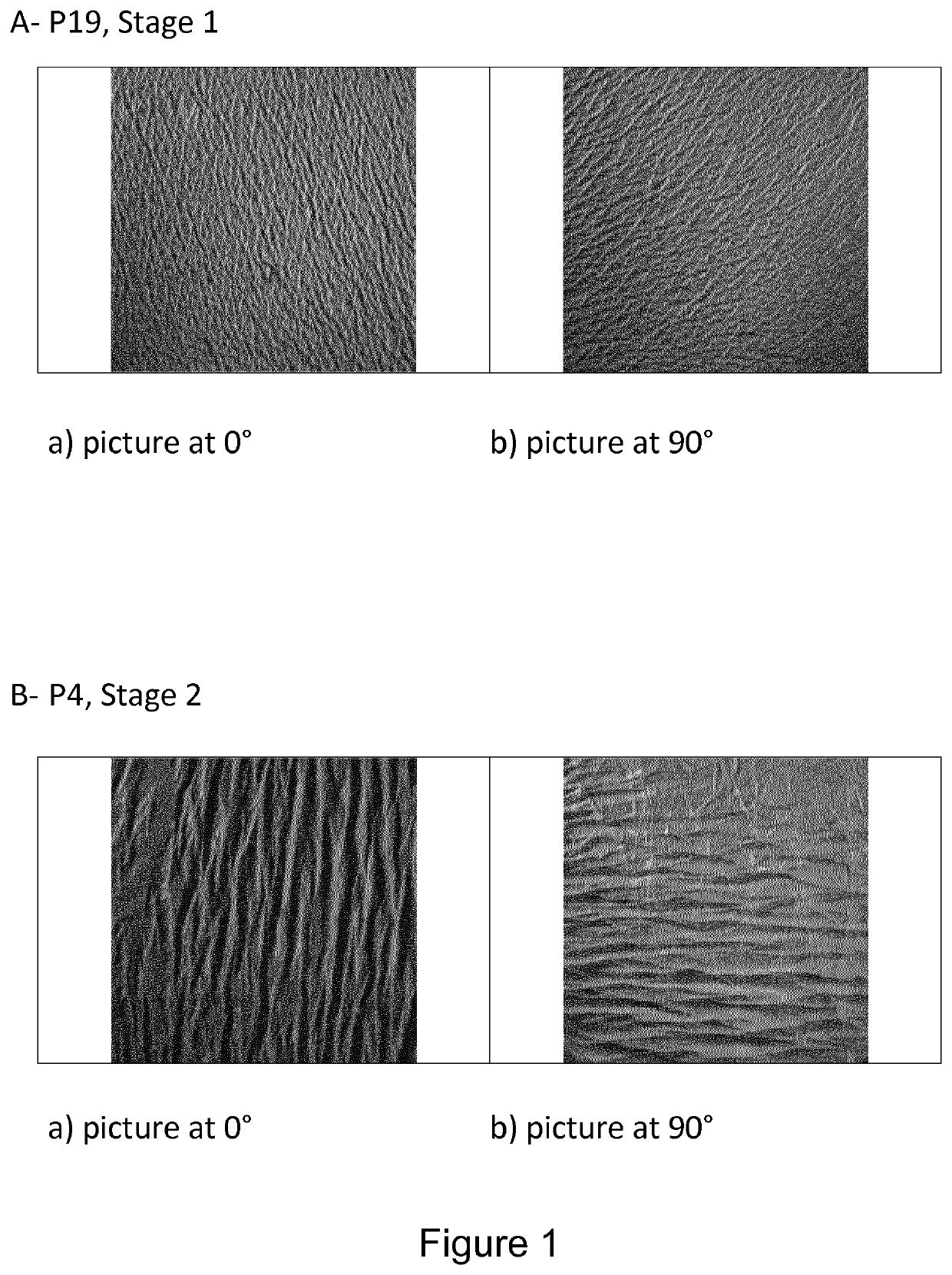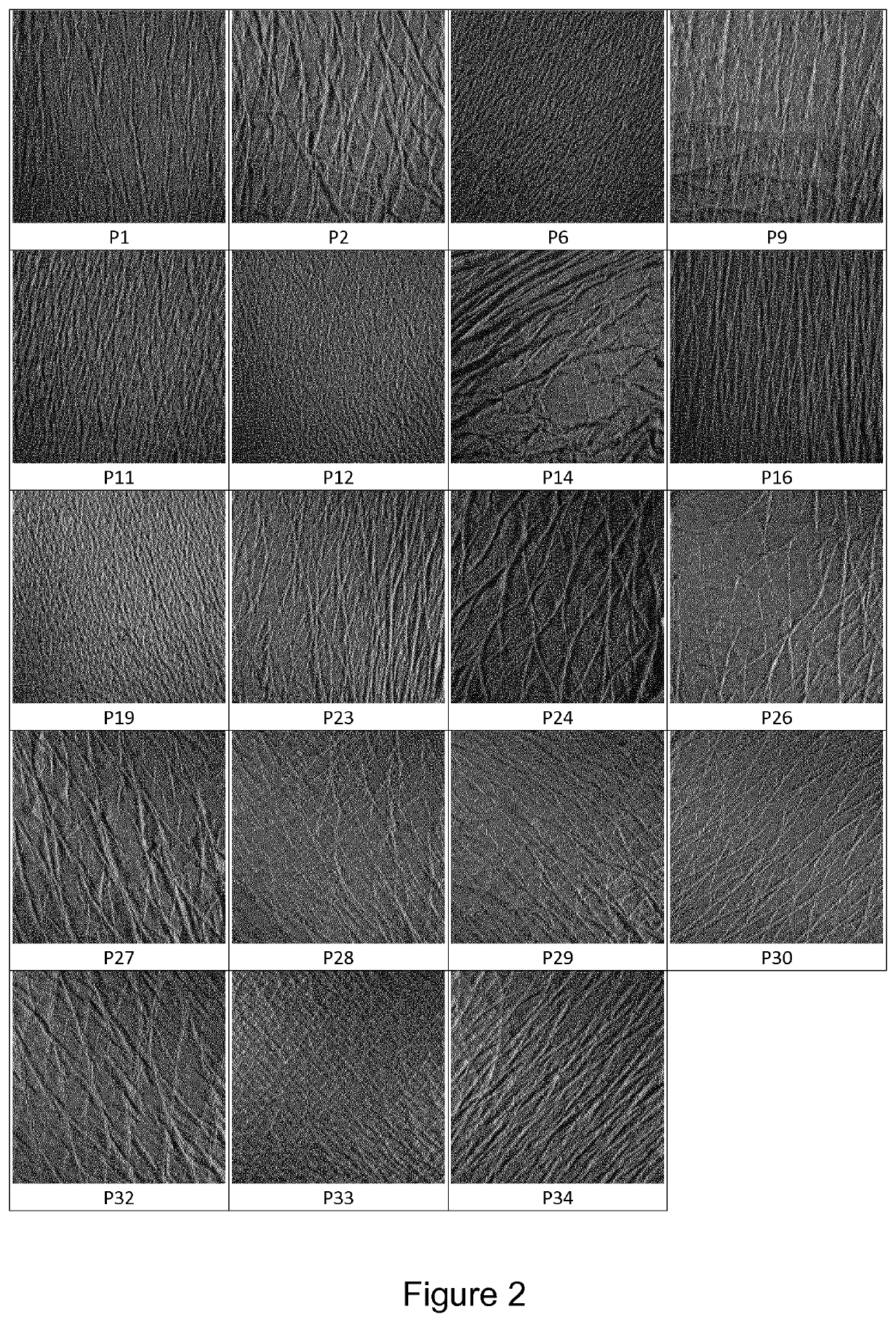Non invasive process for the evaluation of the quality of internal dense connective tissues
- Summary
- Abstract
- Description
- Claims
- Application Information
AI Technical Summary
Benefits of technology
Problems solved by technology
Method used
Image
Examples
example 1
Preparation of Cutaneous Replica of the Skin of the Forearm
[0220]34 patients having suffered a non-pathologic femoral neck fracture, aged of 50 years or more, without any other medical history, have been included in the clinical study. The mean age was 79.4 years. The mean size was 164 cm and the mean weight 63.5 kg. They are denominated hereafter P1 to P34.
[0221]The aim of the clinical study was to identify, if any, a relation between the skin surface microrelief and the quality of the hip bones, and therefore evaluating the risk of occurrence of a contralateral fracture of the hip.
[0222]Silicone replicas were obtained from the anterior part of forearm, on a zone at 5 centimeters distally from the elbow, next to the Flexor Carpi Radialis tendon. A specific device was used for the silicone molding. The silicone polymer is SILFLO®, obtained from Monaderm, Monaco.
[0223]Pictures of the replicas have been obtained for the qualitative analysis of said cutaneous replicas.
[0224]It is essen...
example 2
Qualitative Classification of Cutaneous Replica by Visualization, and Application on the Determination of the Bone Quality
[0229]Using both pictures at 0° and 90°, it is possible to classify visually cutaneous replicas in two groups designated as:[0230]Cutaneous microrelief comprising continuous lines, oriented in multiple directions, are classified as being of “stage 1”;[0231]Cutaneous microrelief comprising short and discontinuous lines, mainly oriented in the same direction, are classified as being “stage 2”.
[0232]An example for both stage 1 and stage 2 is given on FIG. 1 for patients P4 and P19. As shown in this figure, differences between stages 1 and 2 are visible with the naked eye, since microreliefs of stages 1 and 2 present distinct anisotropy and line shape.
[0233]Stage 1 is representative of healthy skins, and stage 2 is representative of altered skins; this last stage is correlated with the natural ageing of the skin and its components.
[0234]Pictures of cutaneous replicas...
example 3
Technique for the Quantitative Classification of Cutaneous Replica, and Application on the Determination of the Bone Quality
[0246]In order to quantify the differences between both stages, and therefore to classify with more details the replicas, a quantitative technique based on the use of an optical sensor was developed. A measurement of the microrelief of each replica picture was realized on a distance of 10 mm, in the longitudinal direction (0°) and the transversal direction (90°) (see FIG. 4A).
[0247]An example of the microrelief obtained by this technique, characterized by the roughness indexes measured in both directions, is presented in FIG. 4B: the cutaneous replica no 16 was assessed as presented above.
[0248]On each roughness profile, x is the distance along the line at the surface of the replica. For each x-value, z corresponds to the distance in the vertical direction between the point at the surface of the replica and the mean line profile.
[0249]From this picture, the num...
PUM
 Login to View More
Login to View More Abstract
Description
Claims
Application Information
 Login to View More
Login to View More - R&D
- Intellectual Property
- Life Sciences
- Materials
- Tech Scout
- Unparalleled Data Quality
- Higher Quality Content
- 60% Fewer Hallucinations
Browse by: Latest US Patents, China's latest patents, Technical Efficacy Thesaurus, Application Domain, Technology Topic, Popular Technical Reports.
© 2025 PatSnap. All rights reserved.Legal|Privacy policy|Modern Slavery Act Transparency Statement|Sitemap|About US| Contact US: help@patsnap.com



